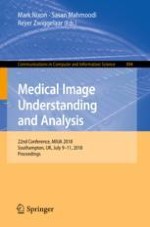2018 | Buch
Medical Image Understanding and Analysis
22nd Conference, MIUA 2018, Southampton, UK, July 9-11, 2018, Proceedings
herausgegeben von: Prof. Mark Nixon, Sasan Mahmoodi, Prof. Reyer Zwiggelaar
Verlag: Springer International Publishing
Buchreihe : Communications in Computer and Information Science
